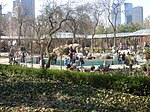Statue of Walter Scott (New York City)
1871 establishments in New York (state)1871 sculpturesBronze sculptures in Central ParkCultural depictions of British menCultural depictions of Scottish men ... and 12 more
Cultural depictions of writersDogs in artMonuments and memorials in ManhattanNew York (state) sculpture stubsNew York City stubsOutdoor sculptures in ManhattanSculptures in Central ParkSculptures of dogs in the United StatesSculptures of men in New York CityStatues in New York CityStatues of writersWalter Scott

Sir Walter Scott is an outdoor bronze portrait statue of Walter Scott and the writer's favorite dog Maida by John Steell, located in Central Park in Manhattan, New York. The memorial sculpture, a replica of the 1845 original in Edinburgh's Scott Monument, was cast in 1871 and dedicated on November 27, 1872. It was donated by resident Scottish-Americans.
Excerpt from the Wikipedia article Statue of Walter Scott (New York City) (License: CC BY-SA 3.0, Authors, Images).Statue of Walter Scott (New York City)
Literary Walk, New York Manhattan
Geographical coordinates (GPS) Address External links Nearby Places Show on map
Geographical coordinates (GPS)
| Latitude | Longitude |
|---|---|
| N 40.77015 ° | E -73.9723 ° |
Address
Walter Scott
Literary Walk
10153 New York, Manhattan
New York, United States
Open on Google Maps










